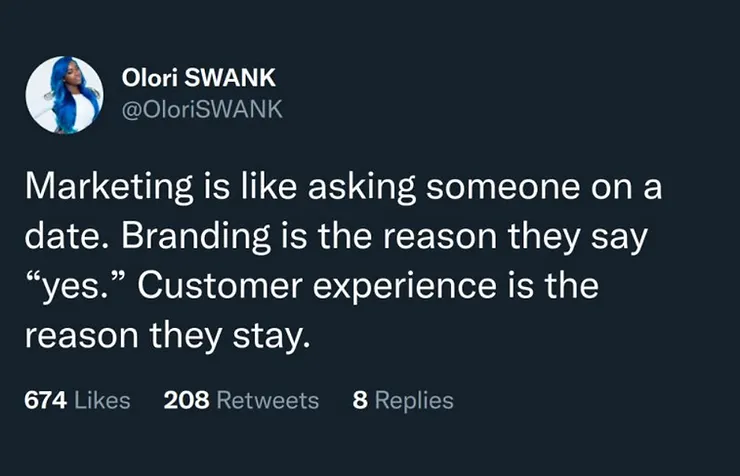
How does branding affect the brand image?


At a certain stage of their development, most companies should devote some attention to the process of creating a specific image.
The image of a company can be compared to the image of each of us: we want to be perceived by others in the best possible way, we strive every day to prove what we are capable of, we have our goals that - in an ideal world - we consistently pursue, and both professionally and personally, we try to be... well, what exactly? That depends on us and how we perceive ourselves and how we want to be perceived by others.
The same applies to companies and how their employees want them to be perceived by the market. Regardless of the company's size and reach, the earlier, the better!
The process of creating a unique identity for a product, service, or company is known as product branding. This process includes all elements that allow a brand to stand out in the market, such as logos, slogans, corporate colors, and other visual elements, as well as the way the company communicates with its audience. The goal of branding is to create a strong, positive perception of the brand among the audience, which attracts and retains customers. Building brand awareness is a key component of this process, as it helps create and maintain brand recognition through various marketing activities.
When we say that a company has a consistent image, we mean that all its marketing and communication activities are consistent and harmoniously aligned, supporting the creation of a recognizable and uniform brand identity. This consistency applies to both the visual aspects of the brand (such as logos, colors, typography) and communication (tone, style, conveyed values), as well as the customer experiences with the brand at every touchpoint.
Visual identity plays a crucial role here, as it helps in understanding the brand's current status, its market positioning, and communication channels.
Important: A consistent image helps build customer trust and loyalty, as it provides them with consistent and predictable experiences with the brand, positively affecting its perception and market value.
Brand Name: The first and fundamental element that identifies the company or product. It should be unique, easy to remember, and stand out from the competition.
Logo: The visual symbol of the brand that succinctly and effectively communicates its essence. The logo is often the first element people associate with a given brand.
Corporate Colors: Carefully selected colors that support brand recognition and communicate its character. These colors are used in all the brand's visual materials.
Typography: Fonts and their usage that are consistently applied in the brand's communication. This includes everything from printed materials to the website.
Slogan/Claim/Tagline: A short, catchy phrase that summarizes the brand's mission, values, or unique proposition. The slogan helps cement the brand in the audience's mind.
Website, Digital Product Appearance, and Online Presence: The design, usability, content of the website, and the way the brand presents itself on social media and other digital platforms.
Tone and Style of Communication: The manner in which the brand communicates with its audience, including the language used and overall communication style. It should be consistent across all channels and customer touchpoints.
Brand Values and History: The beliefs and values that are the foundation of the brand's activities, as well as the story of its inception and development, which help build a deeper connection with the audience. Brand strategy includes branding planning and creating a unique strategy that is consistent and targeted at the appropriate audience.
Customer Experiences: The way the brand engages customers and the quality of the experiences it provides, from customer service to the product itself.
Branding Strategy: The brand's goal, mission, vision, described personas (profiles of target customers), how the company wants to reach them, examples of competitive companies, etc. All these elements work together to build a consistent and compelling brand image that attracts and retains customer loyalty.
What is branding?

Branding is building brand awareness and creating a brand from scratch.
A brand is a lasting, unique business identity that turns consumers into loyal customers.
Personal branding is building a personal brand by managing one's own image.
Employer branding is the way of managing and influencing your reputation as an employer to build the image of an "employer of choice."
Branding produktu focuses on linking the brand identity with a specific product in the portfolio.
Branding should impress consumers (companies define "impression" differently); it helps customers understand what to expect from your company.
Building brand awareness is crucial for a company's success.
Branding brings many benefits, both for the company and the consumer.
Developing a company name is one of the most important stages of branding.
Often overlooked and considered unimportant, these are usually topics that occupy the minds of company owners, who share them sparingly with the rest of the company.
The mission defines the purpose of the company's existence, while the vision shows the direction in which you are heading. It is very important that the brand's mission and vision are described and accessible to all employees! A good idea is to make this document required reading for every new employee.
The mission and vision should be updated regularly.
Simply put, the brand archetype is a set of traits that describe the brand. The archetype is chosen based on the company's values, mission, and vision.
Equally important is the marketing strategy, which is a set of guidelines that the brand must follow to thrive and profit from its products.
The website serves not only an informational function but also an image-building one.
Storytelling in branding refers to telling interesting business stories, also known as narrative marketing.
Quality is understood as delivering products and services that meet customer expectations.
Analysis of the Initial Situation
The first step is to analyze the initial situation.
Creating a Brand Strategy
The next step is to create a brand strategy.
Brand Design
Brand design is the stage where you need to consider how your brand will present itself.
Branding Implementation
Implementation should be preceded by a solid plan.
Brand Communication on Social Media
The brand should be consistently maintained in the audience's awareness.
Analysis of Results and Maintaining Brand Consistency
Creating a brand from scratch requires a lot of work, analysis, and is time-consuming.
Building brand awareness is valuable to stand out in the market and increase the company's value.
Developing a company name is one of the most important stages of branding.
It is worth considering building a brand strategy at the early stages of a company's development.
Creating a brand from scratch requires a lot of work, analysis, and is time-consuming.
A consistent brand image is defined by all its marketing and communication activities that are consistent and harmoniously aligned, supporting the creation of a recognizable and uniform brand identity.


